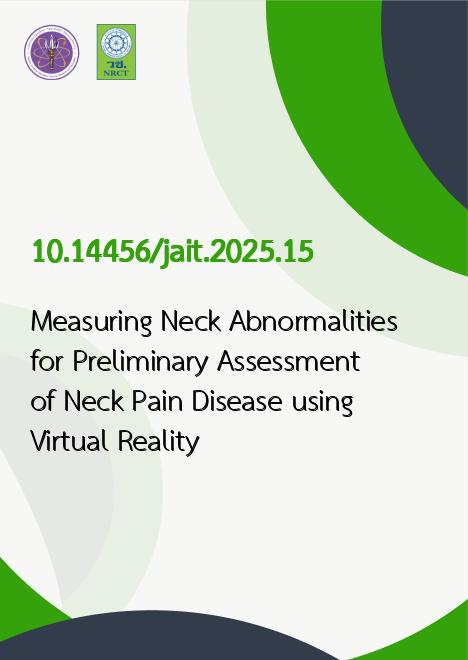
|
Measuring Neck Abnormalities for Preliminary Assessment of Neck Pain Disease using Virtual Reality |
|---|---|
| รหัสดีโอไอ | |
| Creator | Manatsawee Sidajan |
| Title | Measuring Neck Abnormalities for Preliminary Assessment of Neck Pain Disease using Virtual Reality |
| Contributor | Kawintra Sittikraipong, Peerapat Kusumannukul, Sasiwimon Pornwachirawit, Waichaya Suwannakeeree, Sutasinee Jitanan |
| Publisher | Faculty of Informatics, Mahasarakham University |
| Publication Year | 2568 |
| Journal Title | Journal of Applied Informatics and Technology |
| Journal Vol. | 7 |
| Journal No. | 2 |
| Page no. | 235-251 |
| Keyword | Virtual Reality, Measuring Neck Abnormalities, CROM, VAS |
| URL Website | https://ph01.tci-thaijo.org/index.php/jait |
| Website title | Journal of Applied Informatics and Technology |
| ISSN | 3088-1803 |
| Abstract | Neck pain is an increasingly prevalent issue in the general population, leading to a growing incidence of chronic cases and potential future health risks. The economic impact is significant, as individuals with neck pain often cease working due to discomfort. Traditional assessments of treatment effectiveness involve the measurement of neck deformity and movement, typically requiring expensive and limited Cervical Range of Motion (CROM) equipment found primarily in large hospitals. The challenges posed by the COVID-19 outbreak further hinder access to such evaluations. This study proposes the development of a Virtual Reality (VR) application designed to measure neck movement range, enabling users to self-administer assessments under the guidance of the VR application. The VR application development process commences with storyboard creation, all components were designed and creates models object using Blender. The development of VR applications for angle measurement follows the storyboard, was executed using the Unity program. Prioritizing user satisfaction, the application capitalizes on the proven accuracy and reliability of VR devices. Usability experimental focused on user independence, with participants autonomously following instructional videos. Noteworthy user satisfaction, reflected in an average score of 4.36 ± 0.52, underscores the potential of the VR application in addressing neck pain symptoms. The study emphasizes meticulous design considerations, including character and scene elements, aiming to enhance user engagement and immersion in the virtual environment. Users demonstrated focused attention during the measurement process, unaffected by external factors. |